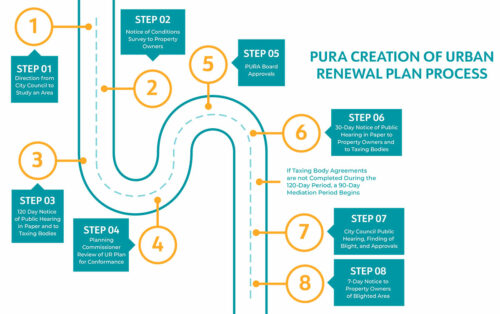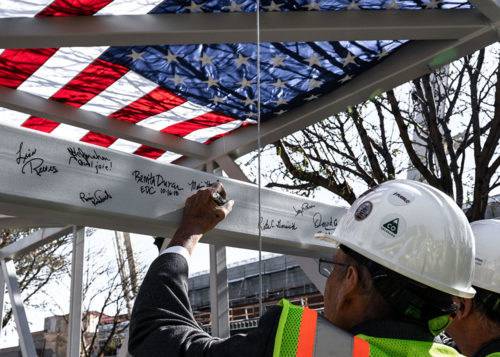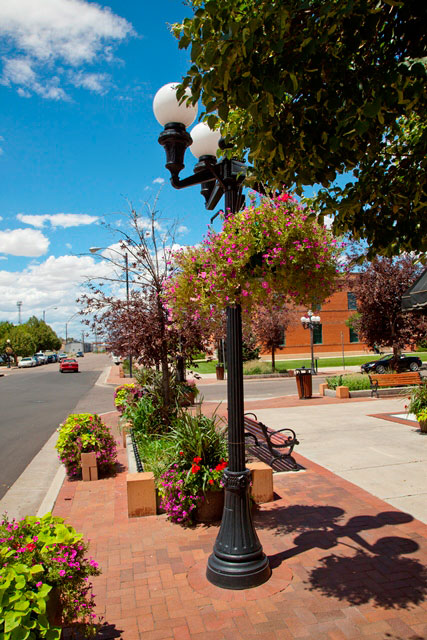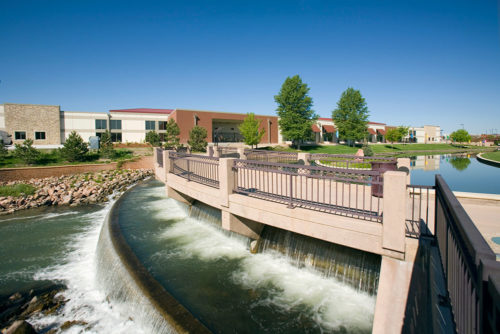Redevelopment and PURA
What Is Redevelopment?
 Redevelopment is a process specifically authorized under the Colorado Urban Renewal Law allowing Pueblo and other local governments to rebuild and revitalize their communities. Moreover, Pueblo Urban Renewal uses redevelopment to address sites within communities that once served as productive but have since deteriorated, are vacant, under-utilized, and need assistance to become viable community areas.
Redevelopment is a process specifically authorized under the Colorado Urban Renewal Law allowing Pueblo and other local governments to rebuild and revitalize their communities. Moreover, Pueblo Urban Renewal uses redevelopment to address sites within communities that once served as productive but have since deteriorated, are vacant, under-utilized, and need assistance to become viable community areas.
PURA forms partnerships with private entities and public sectors to accomplish redevelopment while using tax increment financing (TIF). TIF is a tool available to redevelopment agencies to breathe new life into these sites. As a result, the community benefits from creating new housing, retail, jobs, and tax revenues. In Colorado, more than 30 municipalities have adopted local redevelopment plans.
What is the first step in the redevelopment process?
The first step is to conduct a blight study. This is performed by consultants skilled in conducting blight studies.
A blight study has a two-fold purpose. The first is to determine whether PURA can become involved in a project. The second is to help establish the boundaries of the urban renewal area. Moreover, the boundaries used for the blight study become the boundaries for the urban renewal process in Pueblo. Lastly, in no circumstance may the urban renewal area boundaries be set outside the boundaries of the blight study area.
What happens after the blight study?
If blight is found, the next step in the process is developing a redevelopment plan. Moreover, this will provide a legal framework for implementing redevelopment activities in a project area.

Who approves the redevelopment plan?
A redevelopment plan is approved at public meetings by both the PURA Board of Commissioners and the Pueblo City Council.
Are projects subjected to any kind of design review?
Yes. PURA participates in a design review process, frequently in conjunction with the Planning Office and other city staff. Furthermore, the purpose of the review is to ensure that any redevelopment project fits into city planning objectives.
Who authorizes the use of TIF for a project?
The Pueblo City Council approves the redevelopment plan.
Why is redevelopment important to Pueblo’s future?
Urban Renewal in Pueblo enables our community to redevelop and maintain a strong urban core, essential to economic health. It enhances and expands local businesses, renovates declining housing, and improves public infrastructure systems and facilities. The redevelopment helps encourage new housing and businesses to locate within already developed areas. Furthermore, it reduces crime and long commutes, promotes affordable housing, and helps preserve the environment.

What can redevelopment do for my neighborhood?
Redevelopment can assist in implementing a revitalization effort for areas or conditions unattractive to private-sector developers. This can include, a deteriorating shopping center, an environmentally contaminated site, or an industrial area no longer operating.
Redevelopment plans are always created with input from the area affected so they can respond to a neighborhood’s unique vision and needs.
Urban renewal plans in Pueblo have helped neighborhoods to:
- Stimulate private investment by using new public revenues created by the redevelopment
- Attract new jobs and businesses
- Create more housing, much of it affordable
- Reduce crime
- Build or improve roads, utilities, and public facilities
- Revitalize obsolete or large, vacated facilities
- Preserve and create open space
- Transform hazardous waste sites (called brownfields) into productive uses
- Preserve historic buildings
- Boost property values
- Reduce air pollution and traffic
- Provide needed retail and other services in underserved areas
Check out some of our redevelopment projects that have made a significant impact on the surrounding communities!
How can my community begin to redevelop itself?
The first step is the formation of a redevelopment agency. The Pueblo City Council took that first step in 1959 when it established PURA by city ordinance to revitalize the community. To date, PURA has over nine project areas. PURA participates in development projects by offering direct incentives to private developers or investing in public improvements in designated project areas. Project programs are diverse and range from streetscape improvements and art investment to new development and job creation.
What is PURA?
The Pueblo Urban Renewal Authority (PURA) is an urban renewal authority that serves as the City of Pueblo’s redevelopment agency. An 11-member board of commissioners appointed by the City Council governs PURA.
The primary function is to assist the city in eliminating and preventing slums and blighted areas. Additionally, the authority works in close partnership with the City of Pueblo, the City Council, various agencies, downtown, and neighborhood groups to accomplish urban renewal in Pueblo. Furthermore, the law encourages PURA to maintain flexibility and exercise judgment in determining which projects and activities best achieve its goals. Lastly, the City Council must approve PURA redevelopment plans and the use of TIF.
What law governs PURA?
The Colorado Urban Renewal Law (C.R.S. 31-25-101) governs PURA and all of the state’s urban renewal authorities. It identifies the criteria under which an area can be found to be blighted and thus eligible for redevelopment using TIF. Under the law, urban renewal authorities can use TIF only when the blight criteria contained in the law are met.
The urban renewal law gives PURA and other redevelopment agencies the ability to use eminent domain to assemble private property to accomplish a redevelopment project. PURA uses eminent domain as a tool of last resort when attempts to acquire private property through negotiation fail. Refer to Section 5 below for more information about eminent domain.
Under the law, PURA and other redevelopment agencies may not levy taxes.
Why does PURA get involved in a redevelopment project?
PURA’s mission is to eliminate blighted areas through creative redevelopment. Before the authority may get involved in a project, the area must be found to be blighted. A blighted area means its present condition and use has substantially and adversely affected or slowed the reasonable growth of the community, hindered the provision of decent housing, or constitutes a social liability to the community, and therefore is detrimental to the well-being of the citizens. The Colorado Urban Renewal Law delineates the requirements for determining blight, and if blight is not found, PURA cannot get involved.

What are the factors for determining blight?
There are 11 factors identified in the law for determining blight. Four of them must be found for an area to be declared an urban renewal area. If there is no objection by the property owner(s) and tenants, then only one factor of blight must be present. Moreover, if eminent domain is used, five factors of blight must be found. The following factors are used to determine if an area is blighted:
- Slum, deteriorated, or deteriorating structures
- The predominance of defective or inadequate street layout
- Faulty lot layout concerning size, adequacy, accessibility, or usefulness
- Unsanitary or unsafe conditions
- Deterioration of site or other improvements on the site
- Unusual topography
- Defective or unusual conditions of title which renders the title unmarketable
- The existence of conditions that endanger life or property by fire or other causes
- Buildings that are unsafe or unhealthy for persons to live or work in because of building code violations, dilapidation, deterioration, defective design, physical construction, or faulty or inadequate facilities
- Environmental contamination of buildings or property
- Inadequate public improvements or utilities
If blight is found in my community, what happens next?
PURA must determine how much area will be included in a redevelopment project. Furthermore, it is required by state law to draw the boundaries of the area as narrow as possible to achieve the objectives of the redevelopment plan.
What is a redevelopment plan?
PURA cannot acquire, transfer property, or undertake a redevelopment project until a plan has been adopted by the City Council. Furthermore, the redevelopment plan provides a legal framework for planning and implementing revitalization activities in a project area. However, it can establish the authority to use TIF to help finance a project.

If a redevelopment plan is adopted that includes my home or business, does that mean my home or business is “blighted?”
Not necessarily. Blight is a legal term used solely to determine whether or not your neighborhood can qualify for redevelopment. Furthermore, it does not speak to the condition of each property within a blighted area. PURA and the City Council must find that an area suffers from adverse conditions, defined in the law as blight.
Some areas that qualify for redevelopment may have well-maintained homes or businesses interspersed among deteriorating structures and other conditions of blight. Moreover, if a property is included in a redevelopment project area, it means TIF may be used to stimulate redevelopment.
Do property taxes go up because of redevelopment in an area?
No. Redevelopment does not increase your property taxes. Eventually, there may be an indirect effect if property values eventually increase in a broader area because of the redevelopment.
Does PURA work alone to revitalize neighborhoods?
No, it takes various groups and organizations to accomplish a neighborhood’s redevelopment goals. The agency draws the financial and community resources from the city’s Community Planning and Development Agency, the Office of Economic Development, and the Colorado Housing and Finance Authority. Also included are federal agencies, private foundations, private developers, banks, and other business organizations. Lastly, Colorado Urban Renewal Law requires PURA to partner with private sector developers to leverage TIF resources to the maximum extent feasible.
How does PURA ensure that a redevelopment project will be compatible with the overall planning already in place for a neighborhood?
Every redevelopment project is reviewed by the city of Pueblo Planning and Zoning Commission to determine whether it complies with the city’s Comprehensive Plan.
